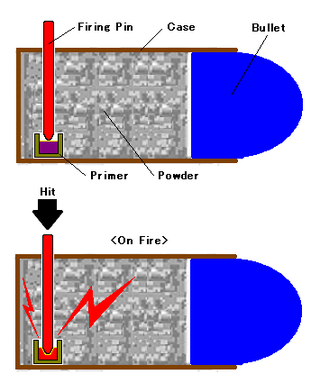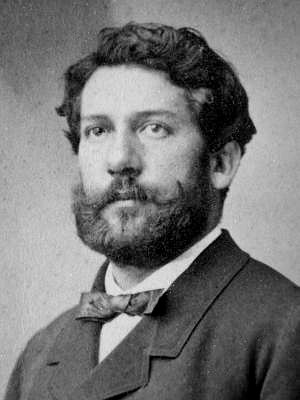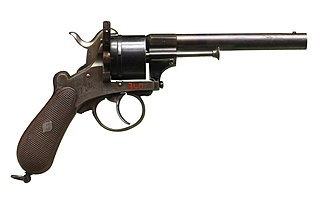
A revolver is a repeating handgun that has at least one barrel and uses a revolving cylinder containing multiple chambers for firing. Because most revolver models hold up to six cartridges before needing to be reloaded, revolvers are also commonly called six shooters.
The 7.62 mm caliber is a nominal caliber used for a number of different cartridges. Historically, this class of cartridge was commonly known as .30 caliber, the equivalent in Imperial and United States Customary measures. It is most commonly used in full-power military main battle rifle (MBR) cartridges. The measurement equals 0.30 inches or three decimal lines, written .3″ and read as three-line.

A cartridge or a round is a type of pre-assembled firearm ammunition packaging a projectile, a propellant substance and an ignition device (primer) within a metallic, paper, or plastic case that is precisely made to fit within the barrel chamber of a breechloading gun, for the practical purpose of convenient transportation and handling during shooting. Although in popular usage the term "bullet" is often informally used to refer to a complete cartridge, the correct usage only refers to the projectile.

In firearms terminology, an action is the functional mechanism of a breech-loading firearm that handles the ammunition cartridges, or the method by which that mechanism works. Actions are technically not present on muzzleloaders, as all those are single-shot firearms with a closed off breech with the powder and projectile manually loaded from the muzzle. Instead, the muzzleloader ignition mechanism is referred to as the lock.

Mauser, originally Königlich Württembergische Gewehrfabrik , was a German arms manufacturer. Their line of bolt-action rifles and semi-automatic pistols has been produced since the 1870s for the German armed forces. In the late 19th and early 20th centuries, Mauser designs were also exported and licensed to many countries which adopted them as military and civilian sporting firearms. The Gewehr 98 in particular was widely adopted and copied, and is the foundation of many of today's sporting bolt-action rifles.

A breechloader is a firearm in which the user loads the ammunition via the rear (breech) end of its barrel, as opposed to a muzzleloader, which loads ammunition via the front (muzzle).

The .45 Colt (11.43×33mmR), is a rimmed, straight-walled, handgun cartridge dating to 1872. It was originally a black-powder revolver round developed for the Colt Single Action Army revolver. This cartridge was adopted by the U.S. Army in 1873 and served as an official US military handgun cartridge for 14 years, before being replaced by the .38 Long Colt in 1892.

The .308 Winchester is a smokeless powder rimless bottlenecked rifle cartridge widely used for hunting, target shooting, police, military, and personal protection applications globally. It is similar but not identical to the 7.62×51mm NATO cartridge.

A pinfire cartridge is an obsolete type of metallic firearm cartridge in which the priming compound is ignited by striking a small pin which protrudes radially from just above the base of the cartridge. Invented by Frenchman Casimir Lefaucheux in 1832, but not patented until 1835, it was one of the earliest practical designs of a metallic cartridge. Its history is closely associated with the development of the breechloader, which replaced muzzle-loading weapons.

The .410 bore is one of the smallest caliber of shotgun shell commonly available. A .410 bore shotgun loaded with shot shells is well suited for small game hunting and pest control. The .410 started off in the United Kingdom as a garden gun along with the .360 and the No. 3 bore rimfire, No. 2 bore rimfire, and No. 1 bore rimfire. .410 shells have similar base dimensions to the .45 Colt cartridge, allowing many single-shot firearms, as well as derringers and revolvers chambered in that caliber, to fire .410 shot shells without any modifications.
Auguste Francotte&Comp. was a privately owned firearms manufacturer based in Liège, Belgium. It was founded between 1805. and 1810, and was still in operation after 1948.

The Nagant M1895 Revolver is a seven-shot, gas-seal revolver designed and produced by Belgian industrialist Léon Nagant for the Russian Empire.

Casimir Lefaucheux was a French gunsmith. He was born in Bonnétable, France and died in Paris, France.

The Lefaucheux M1858 was a French military revolver developed for the navy, chambered for the 12 mm pinfire cartridge, and based on a design by Casimir Lefaucheux and his son, Eugene. The 1854 model was the first metallic-cartridge revolver adopted by a national government; the 1858 was the first variant fielded. It was first issued in 1858 by the French Navy, and though never issued by the French Army, it was used in limited numbers by the French Cavalry during their 1862 deployment to Mexico.

The Geweer M. 95, also known to collectors as the Dutch Mannlicher, was the service rifle of the armed forces of the Netherlands between 1895 and 1940 which replaced the obsolete Beaumont-Vitali M1871/88. At first it was produced by Steyr for the Dutch, but after 1904, production took place under license at a Dutch state weapon factory in Zaandam known by the name of close by Hembrug bridge. Although often regarded as being based on the earlier Mannlicher 1893 Model, the rifle is in fact a modification of the Mannlicher rifle by August Schriever and the Dutch rifle commission. The Dutch issued about 470,000 M.95s.
The .300 Sherwood, also known as the .300 Extra Long and the .300 Westley, is an obsolete centerfire rifle cartridge developed by Westley Richards.

In 1854, Frenchman Eugene Lefaucheux introduced the Lefaucheux Model 1854, notable as being the first revolver to use self-contained metallic cartridges rather than loose powder, pistol ball, and percussion caps. The M1854 model was a single-action, pinfire revolver holding six rounds. It was a French military revolver chambered for the 12 mm pinfire cartridge, based on a design by Casimir Lefaucheux. The M1854 revolver spawned numerous variants, some of which were produced under license in other countries. It was widely exported during the 1860s and sold as both a military and civilian sidearm with either a short or long barrel. Most military models were produced only as single-action weapons, whereas civilian models were made primarily as double-action weapons.
The Danish 1865/97 revolver was a revolver used in the Danish armed forces from 1897 to 1946 as a reserve sidearm not distributed to frontline infantry and instead given to other military units like the artillery who otherwise would not have firearms for self defence.

The 12mm Lefaucheux is a metallic center-fire cartridge. It was originally created as a rimless pinfire cartridge using black powder employed by the French navy on the Lefaucheux M1858 revolver. Later it was adapted to a center-fire cartridge by the French Army in 1873 for use on the MAS 1873 revolver.

Green percussion rifle was a breechloading percussion rifle used in the army of the Principality of Serbia in the second half of the 19. century.
















